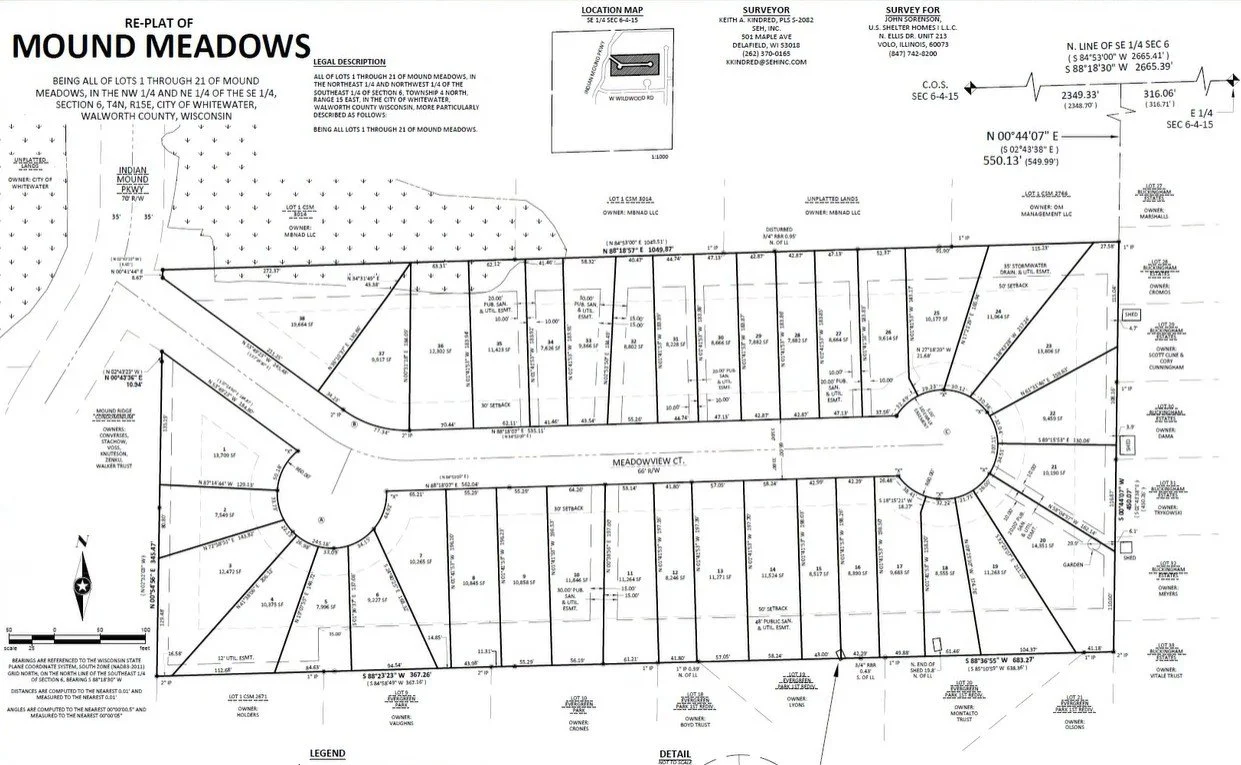Originally posted by John S. Weidl, City Manager, City of Whitewater on LinkedIn
Economic development transcends filling gaps, revitalizing communities, and creating opportunities for long-term prosperity. In Whitewater, the ALDI grocery store, Meadowview Court development, and the final phase of the Park Crest subdivision demonstrate how strategic investments and partnerships transform blighted or stalled developments into thriving assets. By leveraging Tax Increment Financing (TIF) and collaborating with developers, the City has turned challenges into successes that contribute to a stronger, more resilient community.
ALDI: From Food Desert to Economic Anchor
The closure of Whitewater’s only full-service grocery store in 2015 left the community classified as a USDA-designated food desert. The ALDI redevelopment project addressed this critical need and transformed a blighted site into a vibrant commercial hub.
Tackling Site Challenges
The ALDI site previously housed dilapidated apartment buildings and a non-functioning bowling alley. Environmental contamination, including asbestos and lead paint, required significant remediation. With a $500,000 TIF incentive, the City facilitated site cleanup, including asbestos removal, demolition, and the creation of stormwater infrastructure. These efforts enabled ALDI to establish a store that anchors local economic activity while preparing an adjacent pad-ready site for future development.
Economic and Community Impact
The ALDI project created 12–15 jobs with an annual payroll of approximately $350,000. Grocery stores stimulate broader economic activity, driving foot traffic and attracting complementary businesses. Research indicates that every dollar a grocery store spends generates $1.50–$2.00 in local economic activity through job creation and supplier partnerships (Finance Fund, n.d.). The development also supports increased property values, aligning with findings on the significant impact of TIF-funded infrastructure (Carroll, 2008; Merriman et al., 2011).
The Pad-Ready Site: A Win-Win-Win
ALDI’s development addressed immediate community needs and catalyzed opportunities for further growth. The adjacent pad-ready site, valued at an estimated $9.28 million, is projected to contribute $162,400 in annual property tax revenue. This development creates a "win-win-win": Whitewater gains economic vitality, ALDI benefits from increased traffic, and the community secures a platform for additional commercial investment.
Meadowview Court: Revitalizing Stalled Development
The Meadowview Court project exemplifies Whitewater’s commitment to addressing housing affordability while maximizing existing resources. Initially stalled in receivership, the development had unused infrastructure and no tax revenue. Through strategic TIF investments, the City completed the project, revitalizing the site for long-term growth.
Overcoming Challenges
Environmental and construction challenges, including bedrock issues and grading costs, necessitated additional funding. TIF was used to address these expenses and complete unfinished infrastructure, transforming the dormant land into a source of stable tax revenue.
Delivering Long-Term Value
The revitalized Meadowview Court includes 38 single-family attached dwellings, contributing $12 million to the tax base. Residents are projected to generate $2.85–$3.8 million in annual household income, which directly supports local businesses and services. Affordable housing developments like this also stabilize communities, improve workforce retention, and drive local economic activity—every dollar invested generates an estimated $1.70 in local economic impacts (HomeSight, n.d.).
Park Crest Subdivision: Completing the Vision
The final phase of the Park Crest subdivision reflects Whitewater's proactive approach to meeting housing demands. Partnerships with local banks and developers enabled the development of 19 single-family homes, contributing over $7 million to the tax base and adding $1.73 million in annual household spending power to the local economy (Econsult Solutions, Inc., 2021).
Economic Ripple Effects
Households typically allocate 65% of income to goods and services, translating to $91,000 annually per household. Combined with an economic multiplier of 1.5, this spending generates an additional $2.6 million in economic activity, benefiting retail, dining, and services (National Association of Realtors, 2023; National Association of Home Builders, 2020).
Best Practices in TIF: Whitewater’s Approach
The ALDI, Meadowview Court, and Park Crest projects demonstrate several best practices in using TIF:
Revitalizing Receivership Land: Converting stalled developments into productive assets.
Collaborating with Developers: Ensuring smooth approvals, addressing environmental challenges, and aligning projects with community goals.
Targeting Idle Infrastructure: Completing and enhancing prior investments to maximize returns.
Fostering Future Growth: Creating opportunities for future commercial and residential developments.
Spillover Effects and Broader Impacts
Economic Multipliers
The economic activity generated by these projects extends well beyond their initial investments. ALDI’s $350,000 annual payroll creates an estimated $525,000 in additional local economic activity, spurred by spending on suppliers, local businesses, and services (Bivens, 2019). Meadowview Court and Park Crest amplify this impact through residential spending. With households at Park Crest alone contributing $1.73 million in annual spending, the broader economic multiplier effect of 1.5 brings this to a total impact of $2.6 million annually (Econsult Solutions, Inc., 2021). These projects demonstrate how strategic housing and commercial infrastructure investments catalyze sustainable local growth.
Strengthening the Housing Market
Adding 19 single-family homes in Park Crest and 38 single-family attached dwellings in Meadowview Court addresses two critical needs: expanding housing stock and stabilizing the local housing market. New residential developments increase demand for local goods and services while supporting population growth. Additionally, affordable housing options in Meadowview Court contribute to workforce retention, ensuring that Whitewater remains competitive as a community for young professionals and families (National Association of Home Builders, 2020).
Enhancing Workforce and Business Retention
Access to affordable housing and essential services, such as ALDI’s grocery offerings, significantly retain residents and businesses. Stable, affordable neighborhoods help employers attract and retain talent while reducing turnover. This alignment of housing and economic resources fosters a self-reinforcing cycle of growth.
Community Resilience and Quality of Life
The social benefits of these developments are equally impactful. ALDI’s establishment addresses a critical public health need by eliminating Whitewater’s food desert, improving community well-being, and attracting complementary businesses that further enrich the local commercial ecosystem. Similarly, Meadowview Court and Park Crest enhance the quality of life by stabilizing neighborhoods, fostering social cohesion, and making Whitewater more appealing to prospective residents and investors. These outcomes reinforce the city’s long-term resilience.
Conclusion
The ALDI grocery store, Meadowview Court, and Park Crest subdivision exemplify how Whitewater has leveraged TIF and partnerships to transform challenges into opportunities. These projects address critical needs, revitalize underutilized land, and lay the groundwork for a resilient and inclusive future. Whitewater’s success serves as a model for communities seeking sustainable growth and collaborative development.
References
Bivens, J. (2019). Updated employment multipliers for the U.S. economy. Economic Policy Institute. Retrieved from https://www.epi.org/publication/updated-employment-multipliers-for-the-u-s-economy/
Carroll, D. A. (2008). Tax increment financing and property value: An examination of business property using panel data. Urban Affairs Review, 43(4), 520–552. https://doi.org/10.1177/1078087407308659
Econsult Solutions, Inc. (2021). The economic impact of housing development: How housing growth stimulates local economies. Retrieved from https://econsultsolutions.com/economic-impact-housing/
Finance Fund. (n.d.). Economic impacts of supermarkets and other healthy food retail. Retrieved from https://www.financefund.org/userfiles/files/Other%20Documents/Economic%20Impacts%20of%20Supermarkets%20and%20other%20Healthy%20Food%20Retail.pdf
HomeSight. (n.d.). The positive economic impacts of affordable housing. Retrieved from https://homesight.org/the-positive-economic-impacts-of-affordable-housing/
Merriman, D., Skidmore, M., & Kashian, R. (2011). Do tax increment finance districts stimulate growth in real estate values? Real Estate Economics, 39(2), 221–250. https://doi.org/10.1111/j.1540-6229.2010.00291.x
National Association of Home Builders. (2020). Economic impact of home building. Retrieved from https://www.nahb.org/advocacy/top-priorities/economic-impact-of-home-building
National Association of Realtors. (2023). Income required to afford a median-priced home. Retrieved from https://www.nar.realtor/research-and-statistics
State of Wisconsin Department of Revenue. (n.d.). Tax Incremental Financing (TIF) Program Overview. Retrieved from https://www.revenue.wi.gov/Pages/SLF/tif.aspx
Whitewater Economic Development Report. (2023). City of Whitewater.





